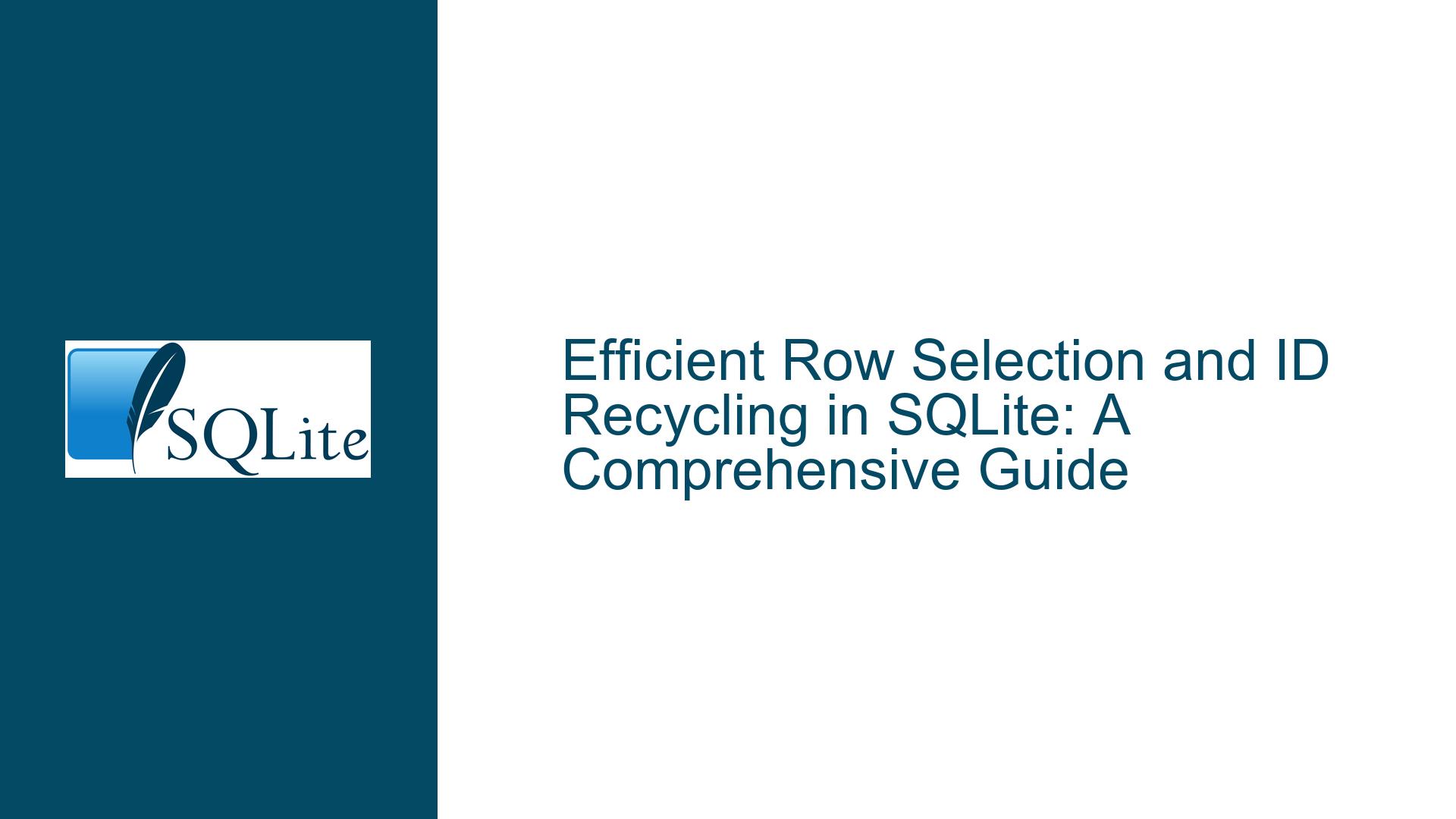Efficient Row Selection and ID Recycling in SQLite: A Comprehensive Guide
Understanding the Need for Efficient Row Selection and ID Recycling
The core issue revolves around efficiently selecting a single row from a table in SQLite, particularly in the context of recycling document IDs (doc_id) from previously deleted records. The user is implementing a back-fill method where they reuse doc_id values from a table (doc_id_gap_array) that stores IDs of deleted documents. When no recycled IDs are available, the system increments the maximum doc_id stored in a special row (doc_id = 0) of the document_state table. The goal is to optimize this process, ensuring that it is both efficient and scalable.
The user initially proposed a method involving multiple steps: selecting and deleting a recycled doc_id from doc_id_gap_array, and if none are available, incrementing the maximum doc_id from document_state. This approach, while functional, raises questions about efficiency and whether SQLite’s built-in mechanisms (such as ROWID management) could simplify the process. Additionally, the discussion touches on the use of prepared statements, caching, and alternative methods like incremental blob I/O for performance optimization.
Exploring the Mechanics of SQLite’s ROWID and AUTOINCREMENT
To understand the user’s approach and its alternatives, it is essential to delve into how SQLite handles row identifiers (ROWID) and the implications of using AUTOINCREMENT. In SQLite, every table has an implicit ROWID column that uniquely identifies each row. When a table is created with an INTEGER PRIMARY KEY column, this column becomes an alias for ROWID. If AUTOINCREMENT is not specified, SQLite will reuse ROWID values from deleted rows when inserting new rows, effectively "back-filling" gaps.
However, if AUTOINCREMENT is used, SQLite ensures that ROWID values always increase and never reuse deleted values. This behavior is achieved by maintaining an internal table (sqlite_sequence) that tracks the maximum ROWID ever used. When the maximum ROWID reaches the largest possible 64-bit integer (9223372036854775807), SQLite will attempt to find an unused ROWID by searching for gaps. If no gaps are found, the insert operation fails with an SQLITE_FULL error.
The user’s concern about AUTOINCREMENT not back-filling gaps is partially valid. Without AUTOINCREMENT, SQLite will reuse ROWID values, but only up to the maximum ROWID ever used. Beyond that point, SQLite will search for gaps, but this is a rare scenario for most applications. The user’s manual approach to recycling doc_id values ensures that gaps are filled regularly, which aligns with their specific requirements.
Optimizing the Process: Prepared Statements, Caching, and Alternative Methods
The discussion suggests several optimizations for the user’s approach. One key recommendation is the use of prepared statements to avoid the overhead of compiling SQL queries repeatedly. Prepared statements are precompiled SQL commands that can be executed multiple times with different parameters, reducing the computational cost of query parsing and planning.
Another suggestion is to warm up the cache by performing a preflight select, which loads data into memory before it is needed. This can be particularly useful in scenarios where the same data is accessed repeatedly in a tight loop. Additionally, selecting multiple rows and holding them in application memory can reduce the number of database queries, further improving performance.
For scenarios where the database is frequently accessed, keeping the database in memory or copying it to an in-memory database can significantly reduce I/O overhead. SQLite supports in-memory databases, which are ideal for temporary data or high-performance applications.
The discussion also mentions incremental blob I/O as an alternative method for accessing data without involving the SQL engine. This approach is more advanced and typically used for handling large binary objects (BLOBs) efficiently. While it may not be directly applicable to the user’s use case, it highlights the flexibility of SQLite in handling different types of data access patterns.
Implementing the Solution: A Step-by-Step Guide
To address the user’s requirements, we can break down the solution into three main steps: selecting a recycled doc_id, incrementing the maximum doc_id when no recycled IDs are available, and inserting a new row into document_state. The goal is to streamline this process into a single set of queries, minimizing the need for application-level logic.
Step 1: Selecting a Recycled doc_id
The first step is to select and delete a recycled doc_id from the doc_id_gap_array table. This can be achieved using a single query with the RETURNING clause, which returns the deleted row’s doc_id:
DELETE FROM doc_id_gap_array
WHERE rowid = (
SELECT rowid FROM doc_id_gap_array LIMIT 1
)
RETURNING doc_id;
This query deletes the first row in doc_id_gap_array (based on rowid) and returns the doc_id of the deleted row. If no rows are available, the query returns an empty result.
Step 2: Incrementing the Maximum doc_id
If no recycled doc_id is available, the system should increment the maximum doc_id stored in the document_state table. This can be done using an UPDATE query with the RETURNING clause:
UPDATE document_state
SET timestamp = timestamp + 1
WHERE doc_id = 0
RETURNING timestamp;
This query increments the timestamp column (which stores the maximum doc_id) for the row where doc_id = 0 and returns the new value. The timestamp column is used here as a placeholder for the maximum doc_id, but it could be renamed for clarity.
Step 3: Inserting a New Row into document_state
Once a doc_id is obtained (either recycled or incremented), a new row can be inserted into the document_state table. This can be done using a standard INSERT query:
INSERT INTO document_state (doc_id, timestamp, state)
VALUES (:doc_id, :timestamp, 1);
Here, :doc_id and :timestamp are placeholders for the values obtained from the previous steps. The state column is set to 1, indicating that the document is active.
Combining the Steps into a Single Transaction
To ensure atomicity and consistency, the entire process should be wrapped in a transaction. This prevents race conditions and ensures that the database remains in a valid state even if an error occurs. The following pseudocode illustrates the combined process:
BEGIN TRANSACTION;
-- Step 1: Select and delete a recycled doc_id
SET doc_id_i = (
DELETE FROM doc_id_gap_array
WHERE rowid = (
SELECT rowid FROM doc_id_gap_array LIMIT 1
)
RETURNING doc_id
);
-- Step 2: If no recycled doc_id is available, increment the maximum doc_id
IF doc_id_i IS NULL THEN
SET doc_id_i = (
UPDATE document_state
SET timestamp = timestamp + 1
WHERE doc_id = 0
RETURNING timestamp
);
END IF;
-- Step 3: Insert a new row into document_state
INSERT INTO document_state (doc_id, timestamp, state)
VALUES (doc_id_i, :timestamp, 1);
COMMIT;
This approach ensures that the entire process is executed as a single atomic operation, minimizing the risk of inconsistencies and improving performance by reducing the number of round-trips to the database.
Addressing Potential Issues and Optimizations
While the proposed solution is efficient, there are several potential issues and optimizations to consider:
Concurrency and Locking
In a multi-user environment, concurrent access to the doc_id_gap_array and document_state tables could lead to race conditions. To mitigate this, SQLite’s locking mechanisms should be used effectively. Wrapping the entire process in a transaction ensures that the database is locked appropriately, preventing other transactions from modifying the data until the current transaction is complete.
Indexing and Query Performance
The performance of the DELETE and UPDATE queries depends on the presence of appropriate indexes. For the doc_id_gap_array table, an index on the rowid column is essential for efficient row selection. Similarly, the document_state table should have an index on the doc_id column to speed up the UPDATE query.
Handling Edge Cases
The solution assumes that the document_state table always contains a row with doc_id = 0. If this row is missing, the UPDATE query will fail. To handle this edge case, the application should ensure that the document_state table is initialized with a row where doc_id = 0 and timestamp is set to the initial maximum doc_id.
Alternative Approaches
While the proposed solution is efficient, alternative approaches could be considered depending on the specific requirements. For example, if the number of recycled doc_id values is small, it might be more efficient to store them in a separate in-memory data structure (e.g., a list or queue) and manage them at the application level. This would reduce the number of database queries but would require additional application logic to handle concurrency and persistence.
Conclusion
Efficiently selecting a row and recycling document IDs in SQLite requires a careful balance between database operations and application logic. By leveraging SQLite’s ROWID management, prepared statements, and transactional guarantees, it is possible to create a robust and efficient solution. The proposed approach combines the selection and deletion of recycled IDs with the incrementing of the maximum ID into a single atomic operation, ensuring consistency and performance. Additionally, considerations around concurrency, indexing, and edge cases are essential for a reliable implementation. While alternative approaches exist, the proposed solution provides a solid foundation for managing document IDs in a SQLite database.






